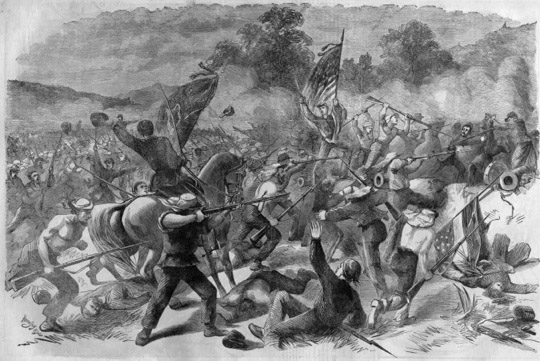The First Battle of Bull Run
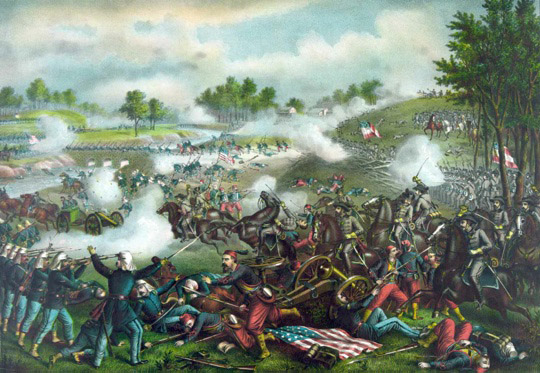
This illustration from Harpers Weekly of August 8, 1863. The caption stated "The Battle of Gettysburg - Longstreet's Attack on our Left Center - Blue Ridge in the Distance - From a Drawing by Mr. A. R. Waud.-
Federal troops led by General McDowell advanced towards Manassas Junction, where Confederate troops were dug in, blocking the road to Richmond. Both Confederate and Union troops were not ready for battle. Union troops advanced on Confederate troops, almost breaking through, but at the last moment, Confederate reinforcements arrived on the battlefield and carried the day. Union troops were routed.
As Washington filled with Union soldiers, the pressure grew to take action. Horace Greely, the mercurial editor of the New York Herald Tribune kept up a constant stream of editorials echoed throughout the Union: " Forward to Richmond- Forward to Richmond"- was the cry.
Army Chief of Staff Winfield Scott put forth a plan to beat the confederacy. He called for a complete blockade of South, followed by a powerful army to seize the Mississippi and New Orleans. Only after all this was accomplished he recommended launching a decisive attack against the center of the Confederacy. He opposed any piecemeal actions. The demands for action however, could not be denied. General McDowell came up with a plan for a direct attack on Confederate troops massed at Manassas Junction on the road to Richmond. One of the keys to the plan called for keeping the 10,000 troops of Confederate General Johnson busy in the Shenandoah Valley, so that he could not reinforce Confederate troops in Manassas Junction commanded by General Beauregard.
General Patterson whose responsibility it was to keep General Johnson's troops occupied in the Shenandoah Valley failed in this objective, and General Johnson began transporting his troops to the South, by train- (the first use of rail in war).
On July 16 General McDowell got his army of 34,000 men in motion from Washington towards the Confederate army. The distance to be covered 30 miles. The union officers had no experience handling such large armies, and the union soldiers had no experience at being soldiers and thus the march took much longer then it should have.
By the first evening advance elements of the army reached Fairfax courthouse. The few Confederate pickets there quickly retreated. On the 18th the first elements reached the hamlet of Centerville. A brigade was sent out from Centerville to reconnoiter the confederate lines, they found the confederates and lost 80 men. General McDowell brought up the balance of his forces.
McDowell had 34,000 troops ready to attack 25,000 Confederate forces spread out over eight miles on the other side of Bull Run. Most of the Confederate forces were clustered on the Confederate right flank, prepared to counterattack. McDowell plan called for a flanking attack on the Confederate left flank. At the same time he would launch diversionary attacks on the Center of the line at the stone bridge and on the right side of the line.
At 2 in the morning McDowell's army began to move. However, it was a long and slow march around the confederate flank. It was not until11 AM that McDowell's 12,000 men completed their march and crossed Bull Run and Sudely Springs. Meanwhile the outlines of the plan had become clear to the Confederate headquarters, and troops began to be switched to meet the attack coming at the left flank. Confederate forces on the spot put up a valiant defense, but the overwhelming size of the Union Army massed at one spot slowly forced the Confederates back. Around noon they were forced to retreat across the turnpike and to take up defensive positions on the hill of the Henry Farm. The Confederates did their best to reinforce the hill, and soon there were 6,000 troops including those led by Wade Hampton and General Thomas Jackson of Virginia. With the confederate line wavering Jackson stood tall and held the line. General Bee trying to rally wavering men, state: "look-There is Jackson standing like a stone wall-rally behind the Virginians". A moment later Bee was mortally wounded. The line held. A few moments later General Johnson gave the order for a counterattack. The Confederate attack quickly broke the Union lines. Before long the retreat of the union army turned into a complete rout. It was impossible to stop the retreating soldiers from heading all the way back to the Potomac River. In the midst of the flight were hundreds of sightseers from Washington, including six senators and ten Congressmen.
As Congressman Riddle stated:
"We called to them, tried to tell them there was no danger, called them to stop, implored them to stand. We called them cowards, denounced them in the most offensive term, put out our heavy revolvers, and threatened to shoot them, but all in vain; a cruel crazy, mad, hopeless panic possessed them, and communicated to everybody about in front and rear. The heat was awful, although now about six; the men were exhausted their mouths' gaped, their lips cracked and blackened with the powder of the cartridges they had bitten off in the battle, their eyes starting in frenzy; no mortal ever saw such a mass of ghastly wretches."
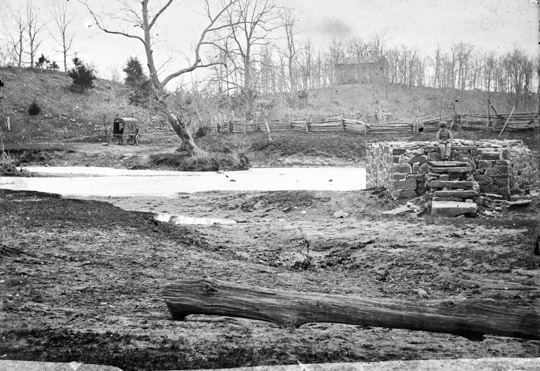
This Gardner photo shows Catharpin Run, Sudley Church, and the remains of the Sudley Sulphur Spring house
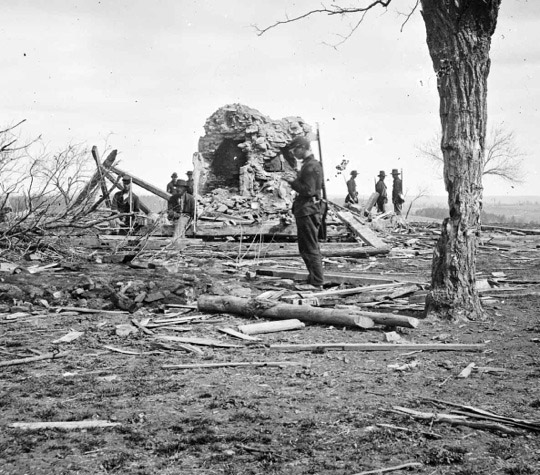
This photograph was taken by George Barnard of the Mrs Judith Henry's house on the Bull Run battlefield

This is a Harpers Weekly Drawing that was titled:SILENCING THE ENEMY'S BATTERIES AT THE BATTLE OF BULL RUN.
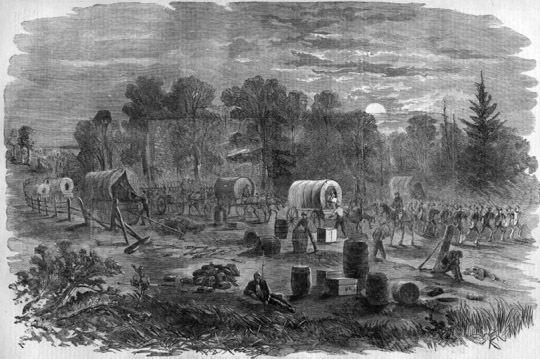
This is a Harpers Weekly Drawing that shows the Union Retreat- it was captioned RETREAT OF OUR TROOPS FROM BULL RUN, BY MOONLIGHT. COLONEL BLENKER'S BRIGADE COVERING..

This is a Harpers Weekly Drawing of the Union wounded being carried.

A drawing of Confederate General Stonewall Jackson at the Battle of Bull Run
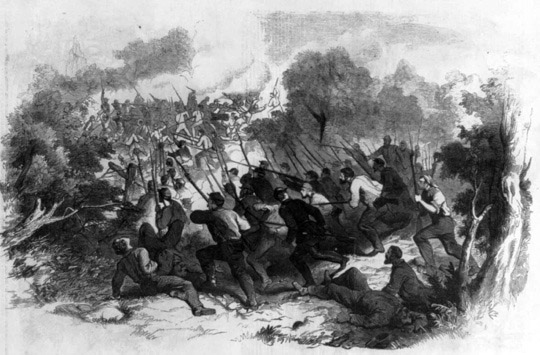
This drawing which appeared in Leslie Illustrated show the NYS 69th assaulting a rebel battery.

This photo taken by George Barnard shows the Robinson House

This photo of the stream with the destroyed bridge in the background.
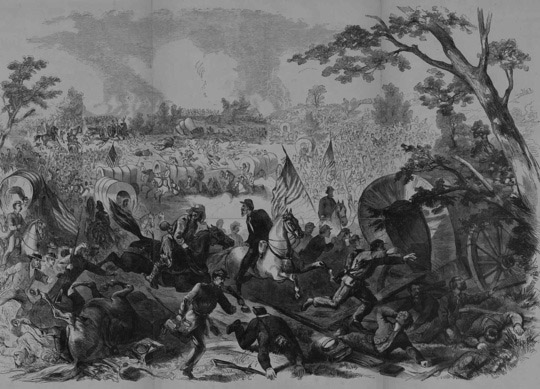
This drawing of the army under General Mcdowell retreating while the the reserve division of Colonel Miles covering the retreat and repelling the Confederate Cavalry. I shows the panic among the stampede. This is one of six plates given with every copy of the book The Soldier in our Civil War published by the J Howard Brown Company
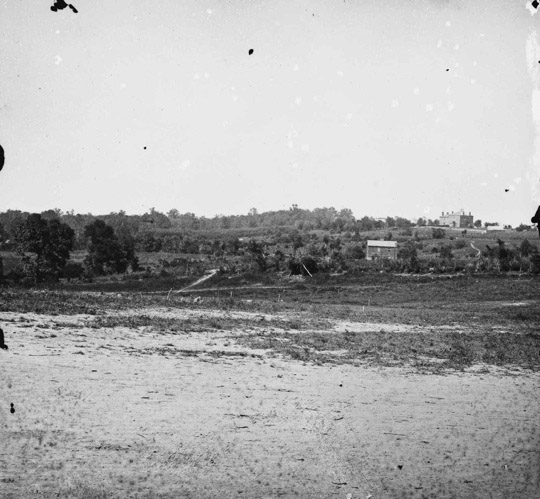
A view of the battlefiels

This photo shows the headquarters of General Beauregard.
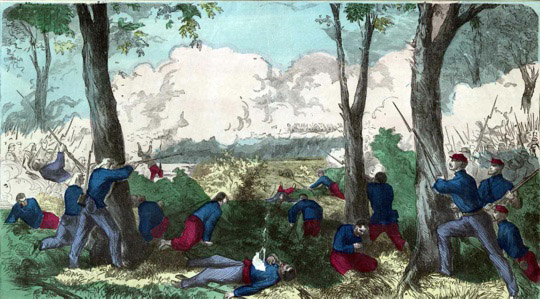
This is a color drawing of of the First Massachusetts Regiment, commanded by Lieutenant- Colonel Welles attacking Confederate Batteries at Bull Run. The drawing was published by H.H. Lloyd and Cos
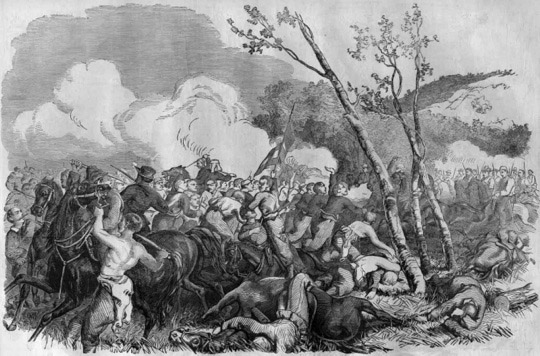
This is a Harpers Weekly drawing shows the the battle itself it was captioned CHARGE OF THE BLACK HORSE CAVALRY UPON THE FIRE ZOUAVES AT THE BATTLE OF BULL RUN.
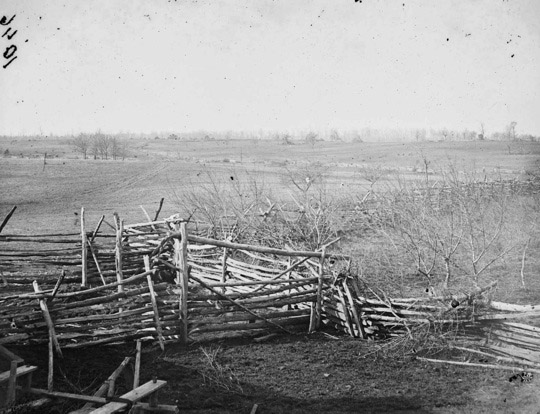
A View of the Battlefield. This photo was taken a year after the battle.

This is a Harpers Weekly Drawing that shows the confederate soldiers killing the union wounded on the battlefield
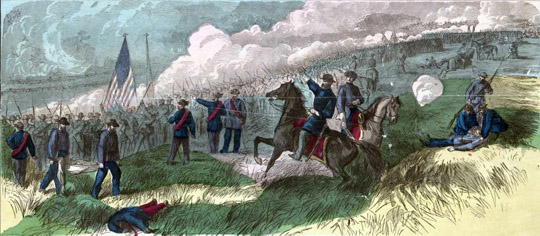
This is a color drawing of Colonel Burnside's Brigade , First and Second Rhode Island, and Seventy-First New York Regiments with their artillery attacking the rebels at Bull Run. The drawing was published by H.H. Lloyd and Cos
